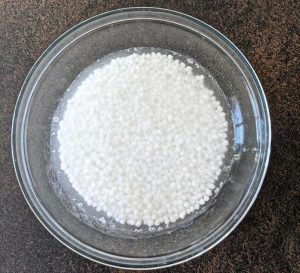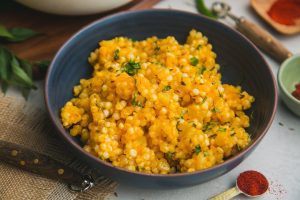Sabudana Khichdi is a beloved Indian dish, often prepared during fasting periods like Navratri, Ekadashi, and Mahashivratri. Made with soaked tapioca pearls (sabudana), roasted peanuts, boiled potatoes, and aromatic spices, this dish is a wholesome and gluten-free meal option.
Its light texture, nutty flavor, and soft, chewy pearls make it a popular choice not just during fasts but also for a quick and nutritious breakfast or snack. However, many struggle to achieve the perfect, non-sticky sabudana khichdi. The key lies in proper soaking, draining, and minimal stirring during cooking.
Let’s dive into the step-by-step recipe to make the best sabudana khichdi
Ingredients:
For Soaking:
- 1 cup sabudana (tapioca pearls)
- 1 cup water (for soaking)
For Cooking:
- 2 tablespoons ghee or oil
- 1 teaspoon cumin seeds
- 2 green chilies, finely chopped
- 1 medium potato, boiled and diced
- ½ cup roasted peanuts, coarsely ground
- ½ teaspoon sugar (optional)
- Salt to taste (use rock salt during fasting)
- Fresh coriander leaves, chopped, for garnish
- Juice of half a lemon
Step-by-Step Instructions:


1. Rinse and Soak Sabudana Properly
- Wash the sabudana under running water until the water turns clear. This step removes excess starch.
- Add 1 cup of water to the washed sabudana, ensuring the pearls are just submerged.
- Cover and let them soak for 4-6 hours or overnight.
- The sabudana should turn soft and double in size after soaking. Drain excess water completely.
2. Prepare the Peanuts
- Dry roast the peanuts in a pan over medium heat until they turn golden brown.
- Let them cool, then rub them between your palms to remove the skins.
- Coarsely grind the peanuts and mix them with the soaked sabudana.
- Add salt and sugar to this mixture and set aside.
3. Cook the Potatoes
- Heat ghee or oil in a pan.
- Add cumin seeds and let them splutter.
- Add chopped green chilies and sauté for a few seconds.
- Toss in the boiled and diced potatoes and cook until lightly golden.
4. Cook the Sabudana Mixture
- Lower the heat and add the sabudana-peanut mixture to the pan.
- Stir gently to combine everything evenly.
- Cook for 5-7 minutes, stirring occasionally, until the sabudana pearls become translucent and are cooked through.
- Avoid overcooking, as it can lead to stickiness.
5. Garnish and Serve
- Once cooked, turn off the heat.
- Add chopped coriander leaves and lemon juice.
- Mix well and serve hot Sabudana Khichdi with curd or coconut chutney.
Tips for a Perfect Non-Sticky Sabudana Khichdi
1. Rinse Well Before Soaking
- Washing the sabudana thoroughly helps remove extra starch, which prevents clumping.
2. Use Minimal Water for Soaking
- The water level should be just enough to cover the sabudana. Too much water can make them mushy.
3. Completely Drain Excess Water
- Before cooking, ensure the sabudana is dry and separate to prevent it from turning sticky.
4. Stir Gently While Cooking
- Avoid over-stirring, as sabudana pearls are delicate and can become mushy when overcooked.
5. Roast and Grind Peanuts
- Peanuts absorb extra moisture and add crunch to the dish.


Health Benefits of Sabudana Khichdi
Sabudana Khichdi is not just a fasting dish, but also a nutritious meal with multiple health benefits:
- Rich in carbohydrates – Provides instant energy.
- Gluten-free – A great alternative for those with gluten intolerance.
- High in fiber – Helps in digestion and keeps the stomach full.
- Good source of protein – Peanuts and potatoes add protein to the dish.
Serving Suggestions
Sabudana Khichdi pairs well with:
Curd or yogurt – Adds a cooling effect.
Coconut chutney – Enhances flavor.
Masala chai – Complements the nutty taste
Variations of Sabudana Khichdi
Want to try something different? Here are some regional variations:
- Maharashtrian Style: Garnished with grated coconut.
- Gujarati Style: Sweeter, with a pinch of jaggery.
- Spicy Version: Extra chilies and black pepper for heat.
Also Read : 6 Step Guide to the Perfect Vegetable Pulao: A Flavor Packed One-Pot Delight
Sabudana Khichdi is a comforting, nutritious, and easy-to-make dish that is perfect for fasting and everyday meals. With the right technique, you can make it fluffy, non-sticky, and delicious every time.


